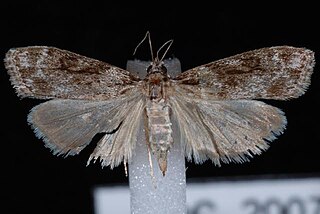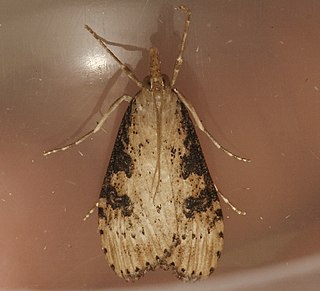
Frechinia is a genus of moths of the family Crambidae.

Mary Esther Murtfeldt was an American entomologist, botanist, botanical collector, writer and editor. She undertook research on the life histories of insects, describing several species new to science and wrote extensively on entomology. Murtfeldt created a collection of plant specimens that contributed to the scientific knowledge on the plants of Missouri.

Elophila tinealis, the black duckweed moth, is a moth in the family Crambidae. It was described by Eugene G. Munroe in 1972. It is found in North America, where it has been recorded from Michigan, Ontario and New York, south to Florida and west to Texas. The habitat consists of swamps and wet woods.

Petrophila canadensis, the Canadian petrophila moth, is a moth in the family Crambidae. It was described by Eugene G. Munroe in 1972. It is found in North America, where it has been recorded from southern Canada and the north-eastern United States.
Undulambia rarissima is a moth in the family Crambidae. It was described by Eugene G. Munroe in 1972. It is found in North America, where it has been recorded from Florida.
Daulia arizonensis is a moth in the family Crambidae. It was described by Eugene G. Munroe in 1957. It is found in North America, where it has been recorded from Arizona and Texas. In the south, the range extends from Mexico to Argentina.

Eudonia spenceri is a moth in the family Crambidae. It was described by Eugene G. Munroe in 1972. It is found in North America, where it has been recorded from California and Arizona to Montana and British Columbia.
Scoparia dominicki is a moth in the family Crambidae. It was described by Eugene G. Munroe in 1972. It is found in North America, where it has been recorded from Florida, North Carolina, Oklahoma, South Carolina and West Virginia.
Frechinia texanalis is a moth in the family Crambidae. It was described by Eugene G. Munroe in 1961. It is found in North America, where it has been recorded from Texas.
Metaxmeste nubicola is a moth in the family Crambidae. It was described by Eugene G. Munroe in 1954. It is found in North America, where it has been recorded from Colorado and Washington. The habitat consists of arctic-alpine areas.
Palpita kimballi, or Kimball's palpita moth, is a moth in the family Crambidae. It was described by Eugene G. Munroe in 1959. It is found in North America, where it has been recorded from Alabama, Florida, Georgia, Louisiana, North Carolina, Oklahoma, South Carolina, Tennessee and Virginia.

Palpita freemanalis, or Freeman's palpita moth, is a moth in the family Crambidae. It was described by Eugene G. Munroe in 1952. It is found in North America, where it has been recorded from Alabama, Illinois, Indiana, Louisiana, Maryland, Mississippi, North Carolina, Oklahoma, South Carolina, Tennessee and Texas.
Udea beringialis is a moth in the family Crambidae. It was described by Eugene G. Munroe in 1966. It is found in North America, where it has been recorded from Alaska, Alberta, British Columbia, Manitoba and the Yukon Territory.
Udea brevipalpis is a moth in the family Crambidae. It was described by Eugene G. Munroe in 1966. It is found in North America, where it has been recorded from California, Colorado and Utah.
Udea cacuminicola is a moth in the family Crambidae. It was described by Eugene G. Munroe in 1966. It is found in North America, where it has been recorded from Colorado and Wyoming.

Udea livida is a moth in the family Crambidae. It was described by Eugene G. Munroe in 1966. It is found in North America, where it has been recorded from British Columbia, Washington and Utah.
Epermenia pimpinella is a moth in the family Epermeniidae. It was described by Mary Murtfeldt in 1900. It is found in North America, where it has been recorded from South Carolina, Ohio, Illinois, Arkansas and Oklahoma.
Helcystogramma chambersella is a moth in the family Gelechiidae. It was described by Mary Murtfeldt in 1874. It is found in North America, where it has been recorded from Pennsylvania, Illinois, Ohio, South Carolina, Tennessee, Louisiana, Mississippi, Florida, Oklahoma, Missouri, Texas, Arizona and California.
Keiferia inconspicuella is a moth in the family Gelechiidae. It was described by Mary Murtfeldt in 1883. It is found in North America, where it has been recorded from the south-eastern and mid-western United States, north to New Jersey and Iowa and west to Nebraska and Texas.

Symmetrischema striatella is a moth in the family Gelechiidae. It was described by Mary Murtfeldt in 1900. It is found in North America, where it has been recorded Alabama, Arkansas, California, Florida, Illinois, Louisiana, Maine, Maryland, Mississippi, Missouri, New Jersey, Oklahoma, South Carolina, Tennessee and Texas. This species has also been accidentally introduced to New Zealand.








